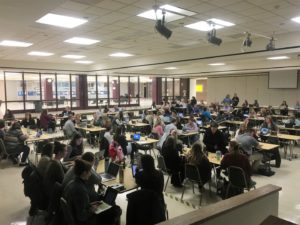Indiana assessment scores show schools ‘have more work to do’
(The Center Square) – Results from this year’s educational assessment tests for Indiana elementary and middle school students show mixed results as children continue their learning recovery as…

(The Center Square) – Results from this year’s educational assessment tests for Indiana elementary and middle school students show mixed results as children continue their learning recovery as the state emerges from the COVID-19 pandemic.
Proficiency scores in math for students in grades three through eight rose 1.5 percentage points from last year, with 40.9% learning at the state’s standards or higher. However, scores for language arts fell by half of a percentage point to 40.7%.
The full data set can be found on the Indiana Department of Education’s website.
Secretary of Education Katie Jenner said the increase in proficiency in math for a second straight year was heartening since learning in that subject had the biggest dropoff during the pandemic. However, Jenner admitted, “there’s no doubt we have more work to do” in helping students.
“English/language arts is an area where many students continue to need additional support, particularly our English Learner and middle school students,” she said. “We knew that experts were projecting years in recovery time, and yet, the urgency is real and requires us all to keep our foot on the gas pedal.”
Jenner called on educators and officials across the state to place emphasis on literacy while at the same time continuing to stress the importance of science, technology, engineering and math – also known as STEM.
Betsy Wiley, president of The Institute for Quality Education, and Robert Enlow, president and CEO of EdChoice, said in a joint statement that the statewide test scores show all of the state’s schools need to improve.
“The rates of proficiency that we observe are not where they need to be if Indiana wants to be a hub of innovation, entrepreneurship, and social mobility,” they said. “The gaps that we observe between different racial groups and between different geographic areas paint a disconcerting picture of the academic quality of our state, a picture that is worrisome for our communities, our democracy, and our economy.”
Still, the school choice proponents found some good news in the results. Proficiency rates at schools accepting vouchers surpassed traditional public schools by more than 16 points in language arts and 11 in math. Rates for Black and Hispanic students at voucher schools were also higher than their peers at traditional public schools.
In Marion County, the state’s most populous, the scores were 24.4 and 22.5 percentage points higher at voucher schools.
“These results show that while there is always room to improve, the students who receive scholarships to attend private schools in Indiana are performing better than their peers in traditional public schools,” they said.
Indiana lawmakers increased their investment in the state’s voucher program earlier this year. The state budget passed in late April expands eligibility for the Choice Scholarship program to families making up to 400% of the income threshold for free and reduced lunches.



